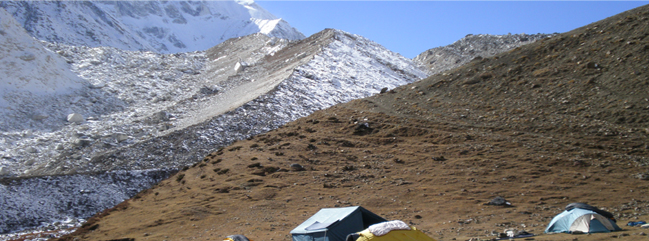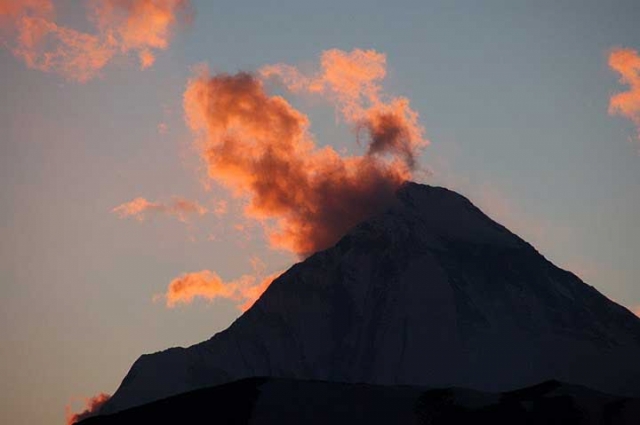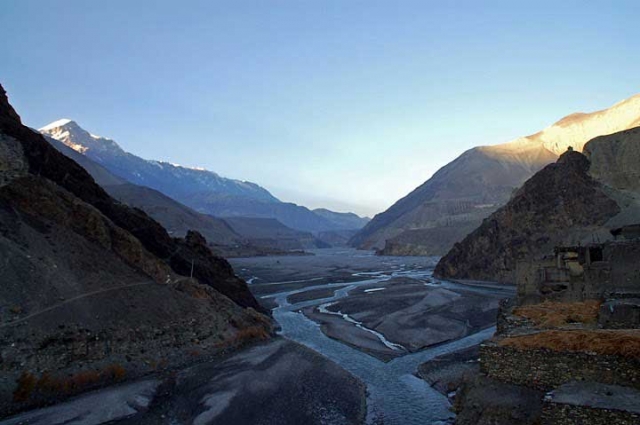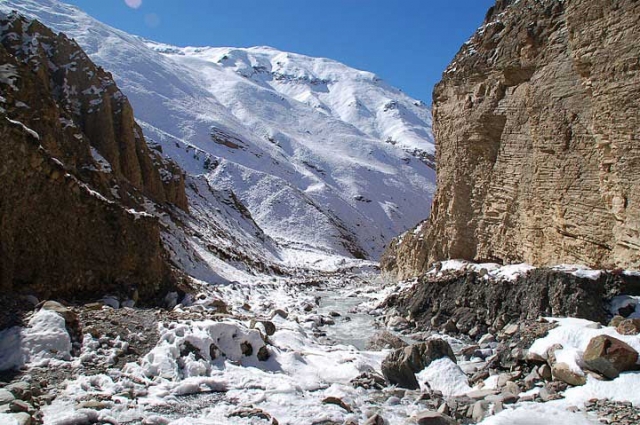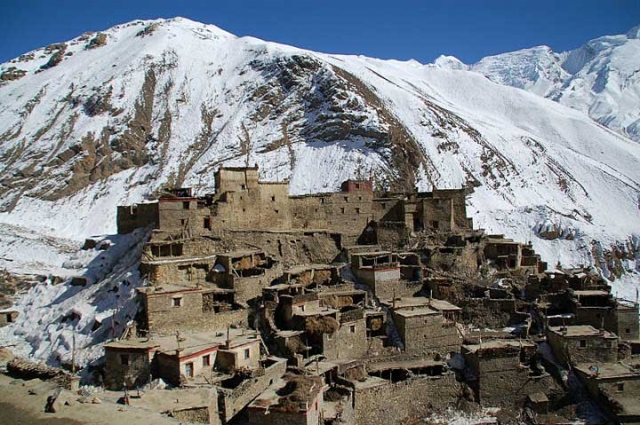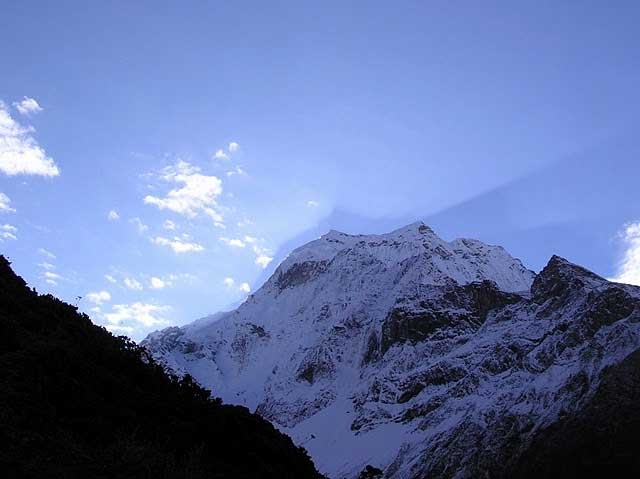Trekking around Manaslu offers a unique opportunity to experience relatively “untouched” region of Nepal. It provides spectacular beauty along the border of Nepal and China and is now a controlled trekking route which allows organized trekking groups special permits to venture round its spectacular circuit. Located in west-central Nepal, the trekking around Manaslu provides fantastic mountain scenery, spanning altitudes from 375 m to 5300 m. A diverse range of ecosystems and ethnic cultures, and a trail that puts one physically closer to Tibet than any other trek in Nepal. Manaslu area people go to the Tibet for buying necessary things such as rice, clothes and Tibetan beer, etc which is cheaper compared to buy in Nepali market. Manaslu trekking possible to make short and long as trekkers demands that mean most of trekkers go to Manaslu and cross Larka La pass then finished the trek in Besi Sahar but some trekkers after crossing Larka La they continue trek to Annapurna circuit, Tilicho Lake or Narphu valley as well as in Manaslu area there is good high pass called Rupinala Pass so it is also possible to include Rupinala pass on Manaslu circuit trek itinerary. Trekking in Manaslu region only possible to operate trek on camping basis / tent camp because Manaslu area there are not available Teahouse /lodge facilities.
Day 01- Arrival in Kathmandu airport (1345meters).
There you will be met by our Airport Representative and transferred to hotel by private tourist vehicle. Overnight at hotel.
Day 02- Pre-trip Meeting and Sightseeing around Kathmandu valley.
In the morning after breakfast at 9 AM, we host a Pre-Trip meeting at your hotel in Kathmandu and introduced your trek Leader/Guide mean time and it will provide an opportunity for individuals to ask questions about the your trek and to introduce you to other participants. This includes a final briefing and preparations for the trip.
PLEASE ADVISE US IF YOU WILL BE ARRIVING LATE AND ARE THEREFORE UNABLE TO ATTEND THE PRE-TRIP MEETING.
In THE PRE-TRIP MEETING All passengers MUST bring:
1. Passport.
2. Four copies of Passport size photos each.
3. Travel Insurance Policy.
4. A writing pen
5. Notepad.
After the Pre-Trip meeting and breakfast your sightseeing trip will start at 9.45 AM in the morning. We provide a private vehicle and professional tour guide. We visit Bodhnath Stupa, one of the biggest Buddhist shrines in the world, where we observe Buddhist monks in prayer in the monasteries surrounding the stupa. After Bodhnath Stupa we visit Pashupatinath, the most famous Hindu temple in the country, located on the banks of the holy Bagmati River. Here we see Hindu holy men (sadhus) meditating, pilgrims bathing and occasionally funeral pyres burning on the ghats. We also visit Bhaktapur Durbar Square, which is a collection of pagoda and shikhara – style temples grouped around a fifty-five-window palace of brick and wood. The attraction of the Bhaktapur Durbar Square is The Lion gate, The Golden gate, The Palace of fifty five windows, Art Galleries, The Statue of King Bhupatindra Malla.
The rest of our time in Kathmandu is free for further exploration and some last-minute shopping in Thamel area near by your hotel. Later, we are supplied with our Trek Pack and departure information for tomorrow. Overnight at hotel.
Day 03: Drive to Arughat (600m) and O/N at Tented Camp.
This day we drive by private bus in the morning to Arughat. During our drive to Arughat we pass Trisuli River (famous for rafting), Akhu River (from Ganesh himal) and Budi Gandaki (from Mt.Manaslu). The road is nice until Dhading Bensi after that there is gravel road .It takes about 7/8 hours driving to get Arughat. The Arughat is the border of Dhading district and Gorkha district. It is big town of this area. We sleep at tent camp here for overnight.
Day 04: Trek to Sati Khola (730m) 4-5 hours walking and O/N at Tented Camp.
Mangaltar- Shanta bazaar- Arkhet Bazaar- Keurenipani- Soti Khola
This morning, our cook will provide wake up tea and a bowl of hot water each of you. After freshen up with hot water. We offer the breakfast and then trek to Soti Khola. Trek to Soti Khola is easy and nice walking. We pass the terrace of rice and millet. During our walking we see the view of Sring Himal. During our hike we pass many small villages like Mangltar, Shanta Bazaar, Arkhet etc. It takes us 4/5 hours walking to Soti Khola and then overnight at tent camp.
ManasluDay 05: Trek to Machhakhola (930m.) 5-6 hours walking and O/N at Tented Camp.
Khursani Bari – Lapubensi – Nauli Khola – Khanibesi – Machhakhola gaon
We get up as usual time in the morning and have breakfast. Today, we trek to Machhakhola Gaon. It is about 5/6 hours walking to get there. During our trek we see many local people and their life style. It makes us more pleasure. Most of the people are from gurung caste in this area. They have their own language and cultural dress. We pass Khursani Bari, Labubensi( Gurung village) and other small village. The trail is up and down hill. We walk left side of the Buri Gandaki River. Finally we get the Machhakhola Goan. It is nice village. It lies near the Buri Gandaki. It is the village of gurung people.
Day 06: trek to Yarukhola (1330m) 6-7 hours walking and O/N at Tented Camp.
Khorlabesi – Tatopani – Dovan – Thuludunga – Yaru Khola.
In this day, we get up and do our morning activities. We have the breakfast and then we start to our trek. It is nice walking trail to Yarukhola. It is about 6/7 hours walking to get there. During our trek, we pass many small villages. We also pass this day Tatopani (Natural Hot spring). The trail to Tatopani is easy . From the hot spring the trail climbs over another ridge, and then crosses the Buri Gandaki on a suspension bridge in a state of moderate decay. Now on the eastern side of the river, the trail climbs on a wide, well-crafted staircase, then across a landslide. The route climbs on a rugged, rocky trail to Yarukhola and then overnight at tent camp / teahouse.
Day 07: Trek to Philim (1590m) 5-6 hours walking and O/N at Tented Camp.
Jagat – Salleri – Sirdibas – Philim
After doing morning usual activities, we have breakfast. We start to hike.After walking while we cross to the west bank of the Buri Gandaki. We continue along the river. During the trek, we pass many nice villages such as Jagat (Conservation and Restricted entry point), Salleri and Sirdibas. In the trail there are decrepit stone kani and several mani walls indicate that the trek is now entering a region of Tibetan influence, although the people are still gurung. Cross the bridge and climb up to Philim, a large gurung village with fields of corn and millet. It takes about 4 hours to get there and the overnight at tent camp/ tea house.
Manaslu Day 08: Trek to Deng (1800m) 6-7 hours walking and O/N at Tented Camp.
Ekle Bhatti – Nigala Gari – Pewa Khola – Deng
This day, we trek to Deng. It is the beautiful walking trail with water fall and pine trees. This day, we split the trail to Sun Valley trail near from Ekle Bhatti. While walking this trail we pass some small village as Ekle Bhatti, Nigala Gari and the Pewa Khola. We cross the bridge of Buri Gandaki many times before the Pewa Khola and we walk through the Bomboo. It is 5hours walking to get Deng. The trail is easy. It is not steep. It is small and nice village.
Day 09: Trek to Ghapsya (2250m) 4-5 hours walking and O/N at the tented camp.
Ranagaon – Bihi Phedi – Ghap – Ghapsya
This day, we start with down hill to the River, cross the Buri Gandaki. We climb up to Ranagaon. It is nice and typical village. After walking little bit you can see the Bihi village. We walk through Bihi Phedi not the village. You can see the view of Buri Gandaki is looking like a tranquil lake above a collection of that form a dam. After walking little bit, there are two trails. One goes through Prok. The Prok has several Gompas. We have to cross Buri Gandaki Bridge to go to Prok. The other trail goes straight to Ghap. We have cross the Sringi Khola Bridge and then continue to Ghapsya. Ghapsya is a small village. It takes about 4-5 hours to get there.
Day 10: Trek to Lho (3180m) 4-5 hours walking and O/N at Tented Camp.
Namrung – Ligaon – Syogaon – Lhogaon
After the breakfast, we start our trek. Beginning of the trail, we walk through the jungle. When we are close to Namrung village the trail is steep up. As soon as we reach in Namrung village we can see view of Himal chilli and others small mountains. Now we enter in upper side of Manaslu where the dialect change to a form of Tibetan and most people dress in chubas, the Tibetan –style wraparound cloak. We pass many walls. It takes 6 hours to get there. Lhogaon is nice village from where you can see the view of Manaslu.
ManasluDay 11: Trek to Samagaon (3517m) 4 hours walking and O/N at Tented Camp. Syalagaon – Samagaon
At the beginning, we drop down to the Damonan Khola, crossing bridge and then ascend to Syalagoan. It is nice, old village. We can see the nice view of Himalchuli (7893m.), Ngadi Chuli (7879m.) and the Manaslu (8163m.). Local people call Manaslu as Ghanpurge. When we cross the Thosang Khola then we descend to Samagaon. It is a big town in this area. It is about 3 hours walking from Lho to Samagaon village. In the afternoon we can walk around Kargyu chholing Gompa and the village.
Day 12: Rest and acclimatization day and O/N at Tented Camp.
It is the day for acclimatization day for us. We do small hiking this day. There are many places for hiking.
Birendra tal (1 hours hiking).
Pungyen Gompa (3-4 hours).
Manaslu Base camp (full day hiking).
Walk around the village.
Note: The acclimatization is for Larka La pass so better not to do long day hiking.
Day 13: trek to Sando (3800m. 3hours walking) and O/N at Tented Camp.
Now we follow it to a wooden bridge over a side stream. The trail to the left leads to Manaslu Base camp. Another trail is for Larke La.The Larya La trail passes several mani walls as the valley begins to widen. It is easy trail on shelf above the river past juniper and birch forests. It is about 3 hours walking to get Samdo. It is small village. You’ll likely have some time to kill so consider hiking up pass the prayer flags to Samdo Peak for fine views of Manaslu.
Day 14: Trek to Dharamashala (4480) 5-6 hours walking and O/N at Tented Camp.
We decend on a wide, gentle trail from Sando past many fields to a large mani wall and stone archway. Drop to the river, which is now very small and narrow, and cross it on a wooden bridge. Iron pole marks the trail climb to Dharmashala. There is right as well. The trail follows the Tibet. We do not take this trail. The trail becomes hard at the beginning but later on it becomes easier. Dharmashala / Larke Rest house has a clammy large stone house for porters and Kitchen. Now there is a nice lodge as well. The trail is about 3-4 hours walking to get there. We can do some hiking rest of the day.
Day 15: Larkya La pass (5113m) 7-8 hours walking and trek down to Bhimtang (3890m) and O/N at Tented Camp.
Today is one of the hardest and long days in this trek. We start our trek 5:30 a.m. in the morning. The trail is not very steep but it is high so we do not feel comfortable to walk here. It takes about 4-5 hours to get top of Larkya La pass. During our trek, we see many Mountain views of Himlung Himal (7126m.), Cheo Himal (6820m.), Gyaji Kung (7030m.), Kang guru (6981m.) and the Annapruna II (7937m.). We also see the many small lakes. We stay at the top for couple of minutes and then we trek down. The down hill trail is very steep. If there is ice, it will be very difficult to get down. It is better if you have crampon. It is about 3-4 hours walking to the Bintang. It is long day to get here.
Day 16: Trek to Gho (3010m) 6 hours walking and O/N at Tented Camp.
Puktu Kharka – Surki – Gho
It is the best place to see wonderful mountains view of Himlung Himal (7126m.), Cheo Himal (6820m.), Gyaji Kung (7030m.), Kang guru (6981m.),Annapruna II (7937m.) and others around us. The trail from Bimtang to Gho is the entire down hill. We walk through the jungle but still we can see the view of Mt. Manaslu and others. This part of walking is very interesting part. If you are lucky you can see wild animal Longur (Monkey) and others. We follow all the way Dudh Khola. It is about 6 hours to get the Gho.
Day 17: Trek to Chamje (430m) 6-7 hours walking and O/N at Tented Camp.
Tilche – Dharapani – Karte – Tal – Chamche
It is way back to Kathmandu. Now most of the trail goes down hill. But we still can see the view of the Manaslu ranges. It is about 2 hours walking, we get Dharapani. It means, we inter in Annapurna region. This is touristy area. Many tourists visit this place. During this hiking, we pass Tilche, Dharapani, Karte, Tal and down to Chamche. It is about 6/7 hours to get here. We can see many tourist who is doing annapurna circuit trek.
Dharapani:
If you have time, we can extend our trip to Annapurna circuit from Dharapani. This trekking is very famous trek around the world.
Day 18: Trek to Bahundanda (1310m) 6 hours walking and O/N at Tented Camp.
Jagat – Syange – Ghermu – Khanigaon – Bahundanda
Day 19: Trek to Besishahar (825m) 5-6 hours walking and O/N at Tented Camp.
Ngadi Bazar – Bhulbhule – Khudi – Besishahar
Day 20- Drive to Kathmandu
Overnight back at the hotel in Kathmandu by bus.
Day 21- Leisure day in Kathmandu.
It’s also spare day in case of bad weather in Lukla, If you are interested in continuing on to Chitwan Jungle Safari, River Rafting Adventure, Kathmandu Shopping Tour you can start today.
Day 22- Transfer to international airport for your final departure.
The trip ends, our Airport Representative will drop you to the Kathmandu international airport for your final flight departure from Nepal.
NOTE: The above information is a guide and standard template of what we provide. The trek can be customized at your request to accommodate your specific requirements.
Note : On adventure trips of this type, weather, local politics, transport or a multitude of other factors beyond our control can result in a change of itinerary. It is, however, very unlikely that the itinerary would be substantially altered; if alterations are necessary the leader will decide what is the best alternative, taking into consideration the best interests of the whole group. Where a change does occur, we do everything we can to minimize its effect, but we cannot be responsible for the results of changes or delays.
Q.What type of shape do I need to be in, is this trip for me?
A. Trekking is suitable for average people who are moderately fit, thus no previous experience is required. Some physical fitness programs such as running, swimming, hiking is recommended before you embark on your journey. Persons suffering from a pre-existing medical condition or disease must seek medical advice before considering the trek. Whilst on the trek, it is common to experience some discomfort before being fully acclimatized.
To prepare for a strenuous trek you should begin training at least two to three months before your departure. As a guideline, an hour of aerobic exercise three to four times per week would be considered a minimum requirement. The best preparation is bushwalking involving relatively steep ascents and descents. If you can manage a couple of valley floor to ridgeline ascents per comfortable and able to enjoy the trek to the fullest. They are physically strong, sharp-witted and have an incredibly positive attitude towards a life that we would consider extremely tough. There is something about a trek in the Himalaya that draws you back time and time again. For keen walkers it is a paradise and even avowed non-walkers find that one foot just seems to follow the other, drawn by the appeal of what lies beyond.
Q. Will somebody come to pick me up at the Airport upon my arrival?
A. Yes, our Airport Representative will be there to greet you outside of Terminal Hall, he/she will be displaying an Kiwi Adventures Treks & Expedition sign board. Upon arrival, you will be transferred to your hotel.
Q. What sort of accommodation can I expect in Kathmandu and in trekking?
A. 11 night’s Trekking Guesthouse, 4 nights three/four star hotels in Kathmandu.
We use standard rooms from three/four star hotels in Kathmandu with breakfast included. Along the trekking routes teahouses/Lodges generally provide basic clean facilities with a mattress and a quilt or blanket. We can also offer you sleeping bags if needed (which need to return after the trip) but it is a good idea to always have your own sleeping equipment. We usually provide single and double rooms as well as the occasional dormitory. The dining room is downstairs around a fire. All food will be cooked to order in the little kitchen. You should not enter the kitchen unless asked to do so.
Q. What sort of food can I expect in trekking?
A. In trekking most teahouses (lodges) cook a delicious range of mostly vegetarian fare. Pasta, tuna bakes, noodles, potatoes, eggs, dhal bhat, bread, soups, fresh vegetables (variety depends on the season) and even some desserts like apple pies, pancakes, and some interesting attempts at custard. You will find a lot of garlic on the menu because it assists with acclimatization – eat some every day. In many larger villages you may find some meat on the menu. You can always get hot chocolate, tea, and hot lemon drinks, as well as soft drinks, and treats like chocolate and crisps.
Each day dinner and breakfast are used to take in the same lodge you spend the night. Lunch will be taken on the way to destination.
Q. What sort of transportation you use?
A. Kiwi Adventures Treks & Expedition is all about providing you with local insights as well as adventure, with that in mind, where we think you will get more out of your holiday by using different means of transport that is what we do. Using a variety of private transport is an integral part of our Himalaya tours and enhances the experience!
We use private tourist vehicles for sightseeing, city tours and pickups. Depending on the group size we use cars, minibus, van or land cruiser. These small light vehicles are more manoeuvrable and flexible enabling us to take you through the Narrow roads of Nepal. All the vehicles are usually air-conditioned unless we are travelling in cooler areas.
Q. What is the best season for this trekking?
A. Our trekking season extends from mid- September to May. From early September the monsoonal rains decrease. By end of September through to December the weather is usually stable with mild to warm days, cold nights. February, March, April, May, October, November, December are the best time to do trek.
Q. What is the weather & temperature like in trekking?
A. Weather in the mountains is notoriously difficult to predict. At night it is generally cooler the days are generally warm. Winter (January and February) will be bit colder but the days can be quite beautiful and warm if the sun is out. There will be bit of snow during the month of January, February and December. It is also important to make sure that you can stay warm and dry in just about any conditions. Expect the unexpected! The temperature could be as high as 20 deg C to -15 deg C low.
Q. Can I charge my digital camera or other batteries on my trip?
A. These facilities will be available in most of the places in your hotel reception by paying some service charges. Remember to bring your adapters!
Q. Is there any communication while we are on trekking?
A. There are telephones in some villages along the trekking routes from which you can make international calls.
Q. Can I use credit cards in the places visit in trekking?
A. In most cities yes, to some extent, however once you leave those cities behind, all you need is cash.
Q. How much additional money do I need per day?
A. In Kathmandu, you can allocate US$ 10 – 25 for a lunch / dinner. It’s all depends on your spending habits. US$7 to 10 US$ a day will be enough to buy bottles of water, chocolates and few drinks in trekking.
Q. Do I need to tip my guide and porters? How much would that be?
A. This is a difficult thing to gauge. We have seen everything from 20USD to 1000 USD per person for guides and porters. Tipping is not required, but a small way to show your guides and local porters thanks for their help. The level of the tip should reflect the level of personal involvement with your guide.
Q. Is the water OK to drink? Do I need to bring purifying tablets/filter?
A. In most places bottled water is readily available. If you wish to drink normal water, you need to use purifying aid, which you will need to bring with you.
Q. Are the Kiwi Adventures Treks & Expedition staff insured?
A. Our company insures all our trekking staff, including guide, cook, sherpa and porters.
Q. What essential documents do I need to bring with me on tour?
A. *Valid Passport – must be valid for up to 6 months after you return from your tour, keep a separate photocopy.
*Travel insurance, keep a separate photocopy
*Cash and Traveller’s Cheques, keep numbers and proof of purchase separate
*Flight tickets
*Emergency contact numbers for T/C’s, banks, insurance, family contacts.
Q. Can I add extra days to my trekking trip?
A. A hoilday should never be about making it to the final point quickly. Along your trek we can add days at your request with additional costs to cover guides, porters, accommodation and food.
Q. Do you use yaks/porters on the trek or do we carry all of our own gear?
A. Whilst on the trek, our porter will take care of your luggage. All you need to carry is your small day bag for your personal belongings like camera, water bottle, sun cream etc only.
Q. What opportunities will I have for shower along the trek?
A. In major places, we arrange guesthouse with hot shower. And in rest of the places, hotel water in bucket will be provided for shower; it would cost you extra about USD 3-4 per shower.
Q. Do you know about how many total miles the trek is?
A. Total distance of the entire trek is about 75 miles.
Cost Includes
• Airport / Hotel / Airport by private car/van/bus.
• Sightseeing/Monument entrance fees.
• Guided city tour in Kathmandu
• Full board meal during trekking with Tea/ coffee (if it is camping trekking our cook prepare all meals).
• Tented / lodge accommodation during the trek. (If it is camping trekking we provide two men share tents, dining tents and tables, kitchen gears, toilet tents etc.)
• A local government license holder Trekking Guide during the trek., a cook, Kitchen boy, Spare, Sherpa required number of porters, their food, accommodation, salary, insurance, equipment, medicine.
• Boiled and purify drinking water for the trek.
• Manaslu restricted trekking permit fee.
• Manaslu / Annapurna Conservation area (MCAP) and (ACAP) permit fee.
• Surface Transfer to and from Kathmandu.
• First aid box.
• All the government taxes.
• Tourist service charge, vat.
• Official expense.
• Local seasonal fresh fruit like orange, banana, apple, grape etc
• Farewell dinner at Kathmandu after the trekking.
• Three night hotel in Kathmandu.
Cost Excludes
• Lunch and dinner whilst in Kathmandu and Pokhara.
• Your travel insurance (compulsory).
• International airfare and airport departure tax.
• Nepal entry visa, you can obtain easily upon your arrival at Tribhuwan International Airport in Kathmandu. (US$ 25 or equivalent foreign currency is required to obtain Tourist Visa with Multiple Entry for 15 days. Likewise, Tourist Visa with Multiple Entry for 30 days can be obtained by paying US $ 40 or equivalent foreign currency. Similarly, Tourist Visa with Multiple Entry for 100 days can be obtained by paying US $ 100. You will also require 2 passport size photos.)
• Items of a personal nature such as alcoholic drinks, cold drinks, laundry.
• Personal trekking Equipment.
• Tips for trekking staff. (Tipping is expected.)
• Any others expenses which are not mentioned on Price Includes section.
